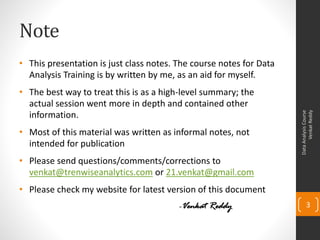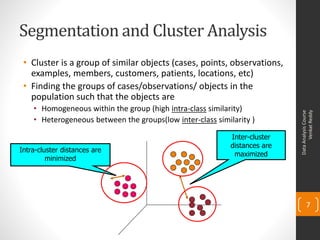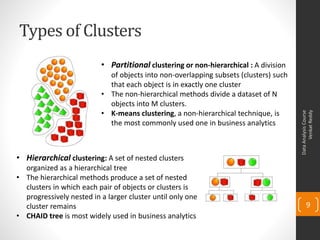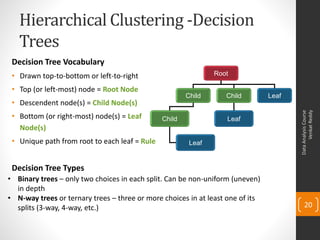Cluster analysis
- 1. Data Analysis Course Cluster Analysis and Decision Trees(version-1) Venkat Reddy
- 2. Data Analysis Course • Data analysis design document • Introduction to statistical data analysis • Descriptive statistics • Data exploration, validation & sanitization • Probability distributions examples and applications Venkat Reddy Data Analysis Course • Simple correlation and regression analysis • Multiple liner regression analysis • Logistic regression analysis • Testing of hypothesis • Clustering and Decision trees • Time series analysis and forecasting • Credit Risk Model building-1 2 • Credit Risk Model building-2
- 3. Note • This presentation is just class notes. The course notes for Data Analysis Training is by written by me, as an aid for myself. • The best way to treat this is as a high-level summary; the actual session went more in depth and contained other Venkat Reddy Data Analysis Course information. • Most of this material was written as informal notes, not intended for publication • Please send questions/comments/corrections to venkat@trenwiseanalytics.com or 21.venkat@gmail.com • Please check my website for latest version of this document -Venkat Reddy 3
- 4. Contents • What is the need of Segmentation • Introduction to Segmentation & Cluster analysis • Applications of Cluster Analysis • Types of Clusters Venkat Reddy Data Analysis Course • Building Partitional Clusters • K means Clustering & Analysis • Building Decision Trees • CHAID Segmentation & Analysis 4
- 5. What is the need of segmentation? Problem: • 10,000 Customers - we know their age, city name, income, employment status, designation • You have to sell 100 Blackberry phones(each costs $1000) to Venkat Reddy Data Analysis Course the people in this group. You have maximum of 7 days • If you start giving demos to each individual, 10,000 demos will take more than one year. How will you sell maximum number of phones by giving minimum number of demos? 5
- 6. What is the need of segmentation? Solution • Divide the whole population into two groups employed / unemployed • Further divide the employed population into two groups high/low salary • Further divide that group into high /low designation 10000 customers Venkat Reddy Data Analysis Course Unemployed Employed 3000 7000 Low salary High Salary 5000 2000 Low High 6 Designation Designation 1800 200
- 7. Segmentation and Cluster Analysis • Cluster is a group of similar objects (cases, points, observations, examples, members, customers, patients, locations, etc) • Finding the groups of cases/observations/ objects in the population such that the objects are • Homogeneous within the group (high intra-class similarity) Venkat Reddy Data Analysis Course • Heterogeneous between the groups(low inter-class similarity ) Inter-cluster distances are Intra-cluster distances are maximized minimized 7
- 8. Applications of Cluster Analysis • Market Segmentation: Grouping people (with the willingness, purchasing power, and the authority to buy) according to their similarity in several dimensions related to a product under consideration. • Sales Segmentation: Clustering can tell you what types of customers buy what products Venkat Reddy Data Analysis Course • Credit Risk: Segmentation of customers based on their credit history • Operations: High performer segmentation & promotions based on person’s performance • Insurance: Identifying groups of motor insurance policy holders with a high average claim cost. • City-planning: Identifying groups of houses according to their house type, value, and geographical location • Geographical: Identification of areas of similar land use in an earth 8 observation database.
- 9. Types of Clusters • Partitional clustering or non-hierarchical : A division of objects into non-overlapping subsets (clusters) such that each object is in exactly one cluster • The non-hierarchical methods divide a dataset of N objects into M clusters. • K-means clustering, a non-hierarchical technique, is Venkat Reddy Data Analysis Course the most commonly used one in business analytics • Hierarchical clustering: A set of nested clusters organized as a hierarchical tree • The hierarchical methods produce a set of nested clusters in which each pair of objects or clusters is progressively nested in a larger cluster until only one cluster remains 9 • CHAID tree is most widely used in business analytics
- 10. Cluster Analysis -Example Maths Science Gk Apt Maths Science Gk Apt Student-1 94 82 87 89 Student-1 94 82 87 89 Student-2 46 67 33 72 Student-2 46 67 33 72 Student-3 98 97 93 100 Student-3 98 97 93 100 Student-4 14 5 7 24 Student-4 14 5 7 24 Student-5 86 97 95 95 Student-5 86 97 95 95 Student-6 34 32 75 66 Student-6 34 32 75 66 Student-7 69 44 59 55 Student-7 69 44 59 55 Venkat Reddy Data Analysis Course Student-8 85 90 96 89 Student-8 85 90 96 89 Student-9 24 26 15 22 Student-9 24 26 15 22 Maths Science Gk Apt Student-4 14 5 7 24 2,7 Student-9 24 26 15 22 4,9,6 Student-6 34 32 75 66 Student-2 46 67 33 72 Student-7 69 44 59 55 8,5,1,3 Student-8 85 90 96 89 Student-5 86 97 95 95 10 Student-1 94 82 87 89 Student-3 98 97 93 100
- 11. Building Clusters 1. Select a distance measure 2. Select a clustering algorithm 3. Define the distance between two clusters 4. Determine the number of clusters 5. Validate the analysis Venkat Reddy Data Analysis Course • The aim is to build clusters i.e divide the whole population into group of similar objects • What is similarity/dis-similarity? 11 • How do you define distance between two clusters
- 12. Distance measures • To measure similarity between two observations a distance measure is needed. With a single variable, similarity is straightforward • Example: income – two individuals are similar if their income level is similar and the level of dissimilarity increases as the Venkat Reddy Data Analysis Course income gap increases • Multiple variables require an aggregate distance measure • Many characteristics (e.g. income, age, consumption habits, family composition, owning a car, education level, job…), it becomes more difficult to define similarity with a single value • The most known measure of distance is the Euclidean distance, which is the concept we use in everyday life for 12 spatial coordinates.
- 13. Examples of distances A x xkj n 2 Dij ki Euclidean distance k 1 B n A Dij xki xkj City-block (Manhattan) distance k 1 B Venkat Reddy Data Analysis Course Dij distance between cases i and j xkj - value of variable xk for case j Other distance measures: Chebychev, Minkowski, Mahalanobis, maximum distance, cosine similarity, simple correlation between observations etc., Data matrix Dissimilarity matrix x11 ... x1f ... x1p 0 d(2,1) ... ... ... ... ... 0 13 x ... xif ... xip d(3,1) d ( 3,2) 0 i1 ... ... ... ... ... : : : x xnp d ( n,1) d ( n,2) ... ... xnf ... ... 0 n1
- 14. K -Means Clustering – Algorithm 1. The number k of clusters is fixed 2. An initial set of k “seeds” (aggregation centres) is provided 1. First k elements 2. Other seeds (randomly selected or explicitly defined) 3. Given a certain fixed threshold, all units are assigned to the Venkat Reddy Data Analysis Course nearest cluster seed 4. New seeds are computed 5. Go back to step 3 until no reclassification is necessary Or simply Initialize k cluster centers Do Assignment step: Assign each data point to its closest cluster center Re-estimation step: Re-compute cluster centers 14 While (there are still changes in the cluster centers)
- 15. K Means clustering in action • Dividing the data into 10 clusters using K-Means Distance metric will decide cluster for these points Venkat Reddy Data Analysis Course 15
- 16. SAS Code & Options proc fastclus data= mylib.super_market_data radius=0 replace=full maxclusters =3 maxiter =20 list distance; id cust_id; var age income spend family_size visit_Other_shops; run; Options Venkat Reddy Data Analysis Course • The RADIUS= option establishes the minimum distance criterion for selecting new seeds. No observation is considered as a new seed unless its minimum distance to previous seeds exceeds the value given by the RADIUS= option. The default value is 0. • The MAXCLUSTERS= option specifies the maximum number of clusters allowed. If you omit the MAXCLUSTERS= option, a value of 100 is assumed. • The REPLACE= option specifies how seed replacement is performed. • FULL :requests default seed replacement. • PART :requests seed replacement only when the distance between the observation and the closest seed is greater than the minimum distance between seeds. • NONE : suppresses seed replacement. 16 • RANDOM :Selects a simple pseudo-random sample of complete observations as initial cluster seeds.
- 17. SAS Code & Options • The MAXITER= option specifies the maximum number of iterations for re computing cluster seeds. When the value of the MAXITER= option is greater than 0, each observation is assigned to the nearest seed, and the seeds are recomputed as the means of the clusters. • The LIST option lists all observations, giving the value of the ID variable (if any), the number of the cluster to which the observation is assigned, and Venkat Reddy Data Analysis Course the distance between the observation and the final cluster seed. • The DISTANCE option computes distances between the cluster means. • The ID variable, which can be character or numeric, identifies observations on the output when you specify the LIST option. • The VAR statement lists the numeric variables to be used in the cluster analysis. If you omit the VAR statement, all numeric variables not listed in other statements are used. 17
- 18. Lab- Clustering • Retail Analytics problem: Supermarket data. A super market want to give a special discount to few selected customers. The aim to increase the sales by studying the buying capacity of the customers • Find the customer segments using cluster analysis code(do not mention maxclusters) Venkat Reddy Data Analysis Course • How many clusters have been created? • What are the properties of customers in each cluster? • Analyze the output and identify the customer group with good income, high spend, large family size. • How much time does it take to create the clusters? • Now create 5 clusters using K means clustering techniques • Find the target customer group • Further clustering in cluster 3? 18
- 19. SAS output interpretation • RMSSTD - Pooled standard deviation of all the variables forming the cluster. Since the objective of cluster analysis is to form homogeneous groups, the • RMSSTD of a cluster should be as small as possible • SPRSQ -Semipartial R-squared is a measure of the homogeneity of merged clusters, so SPRSQ is the loss of homogeneity due to combining two groups or clusters to form a new group or cluster. Venkat Reddy Data Analysis Course • Thus, the SPRSQ value should be small to imply that we are merging two homogeneous groups • RSQ (R-squared) measures the extent to which groups or clusters are different from each other • So, when you have just one cluster RSQ value is, intuitively, zero). Thus, the RSQ value should be high. • Centroid Distance is simply the Euclidian distance between the centroid of the two clusters that are to be joined or merged. • So, Centroid Distance is a measure of the homogeneity of merged clusters and the 19 value should be small.
- 20. Hierarchical Clustering -Decision Trees Decision Tree Vocabulary • Drawn top-to-bottom or left-to-right Root • Top (or left-most) node = Root Node Child Child Leaf • Descendent node(s) = Child Node(s) Venkat Reddy Data Analysis Course • Bottom (or right-most) node(s) = Leaf Child Leaf Node(s) • Unique path from root to each leaf = Rule Leaf Decision Tree Types • Binary trees – only two choices in each split. Can be non-uniform (uneven) in depth • N-way trees or ternary trees – three or more choices in at least one of its splits (3-way, 4-way, etc.) 20
- 21. Decision Tree-Example Maths Science Gk Apt Maths Science Gk Apt Student-1 94 82 87 89 Student-1 94 82 87 89 Student-2 46 67 33 72 Student-2 46 67 33 72 Student-3 98 97 93 100 Student-3 98 97 93 100 Student-4 14 5 7 24 Student-4 14 5 7 24 Student-5 86 97 95 95 Student-5 86 97 95 95 Student-6 34 32 75 66 Student-6 34 32 75 66 Student-7 69 44 59 55 Student-7 69 44 59 55 Venkat Reddy Data Analysis Course Student-8 85 90 96 89 Student-8 85 90 96 89 Student-9 24 26 15 22 Student-9 24 26 15 22 Maths Science Gk Apt Student-4 14 5 7 24 1-10 Student-9 24 26 15 22 Student-6 34 32 75 66 2,7,8,5,1, Student-2 46 67 33 72 4,9,6 3 Student-7 69 44 59 55 Student-8 85 90 96 89 Student-5 86 97 95 95 2,7 8,5,1,3 21 Student-1 94 82 87 89 Student-3 98 97 93 100
- 22. Decision Trees Algorithm (1) Which attribute to start? Venkat Reddy Data Analysis Course (2) Which node to proceed? (3) Which attribute to proceed with? (4) When to stop/ come to conclusion? 1. Start with best split attribute at root 22 2. Split the population into heterogeneous groups 3. Go to each group and repeat step 1 and 2 until there is no further best split
- 23. Best Splitting attribute • The best split at root(or child) nodes is defined as one that does the best job of separating the data into groups where a single class predominates in each group • Example: Population data input variables/attributes include: Height, Gender, Age Venkat Reddy Data Analysis Course • Split the above according to the above “best split” rule • Measure used to evaluate a potential split is purity • The best split is one that increases purity of the sub-sets by the greatest amount • Purity (Diversity) Measures: • Gini (population diversity) • Entropy (information gain) • Information Gain Ratio • Chi-square Test 23
- 24. Clustering SAS Code & Options proc cluster data= mylib.cluster_data simple noeigen method=centroid rmsstd rsquare nonorm out=tree; id cust_id; var age income spend family_size Other_shops; run; Options Venkat Reddy Data Analysis Course • SIMPLE: The simple option displays simple, descriptive statistics. • NOEIGEN: The noeigen option suppresses computation of eigenvalues. Specifying the noeigen option saves time if the number of variables is large • The METHOD= specification determines the clustering method used by the procedure. Here, we are using CENTROID method. • The RMSSTD option displays the root-mean-square standard deviation of each cluster. • The RSQUARE option displays the R2 and semipartial R2 to evaluate cluster solution. • The NONORM option prevents the distances from being normalized to unit mean or unit root mean square with most methods. 24
- 25. Lab: Hierarchical clustering • Build hierarchical clusters for the supermarket data • Draw the tree diagram • What are the properties of customers in each cluster? • Analyze the output and identify the customer group with good Venkat Reddy Data Analysis Course income, high spend, large family size. 25
- 26. SAS output interpretation • RMSSTD - Pooled standard deviation of all the variables forming the cluster. Since the objective of cluster analysis is to form homogeneous groups, the • RMSSTD of a cluster should be as small as possible • SPRSQ -Semipartial R-squared is a measure of the homogeneity of merged clusters, so SPRSQ is the loss of homogeneity due to combining two groups or clusters to form a new group or cluster. Venkat Reddy Data Analysis Course • Thus, the SPRSQ value should be small to imply that we are merging two homogeneous groups • RSQ (R-squared) measures the extent to which groups or clusters are different from each other • So, when you have just one cluster RSQ value is, intuitively, zero). Thus, the RSQ value should be high. • Centroid Distance is simply the Euclidian distance between the centroid of the two clusters that are to be joined or merged. • So, Centroid Distance is a measure of the homogeneity of merged clusters and the 26 value should be small.
- 27. CHAID Segmentation • CHAID- Chi-Squared Automatic Interaction Detector • CHAID is a non-binary decision tree. • The decision or split made at each node is still based on a single variable, but can result in multiple branches. • The split search algorithm is designed for categorical variables. Venkat Reddy Data Analysis Course • Continuous variables must be grouped into a finite number of bins to create categories. • A reasonable number of “equal population bins” can be created for use with CHAID. • ex. If there are 1000 samples, creating 10 equal population bins would result in 10 bins, each containing 100 samples. • A Chi-square value is computed for each variable and used to determine the best variable to split on. 27
- 28. CHAID Algorithm 1. Select significant independent variable 2. Identify category groupings or interval breaks to create groups most different with respect to the dependent variable Venkat Reddy Data Analysis Course 3. Select as the primary independent variable the one identifying groups with the most different values of the dependent variable based on chi-square 4. Select additional variables to extend each branch if there are further significant differences 28
- 29. Venkat Reddy Konasani Manager at Trendwise Analytics venkat@TrendwiseAnalytics.com 21.venkat@gmail.com Venkat Reddy Data Analysis Course +91 9886 768879 29





























